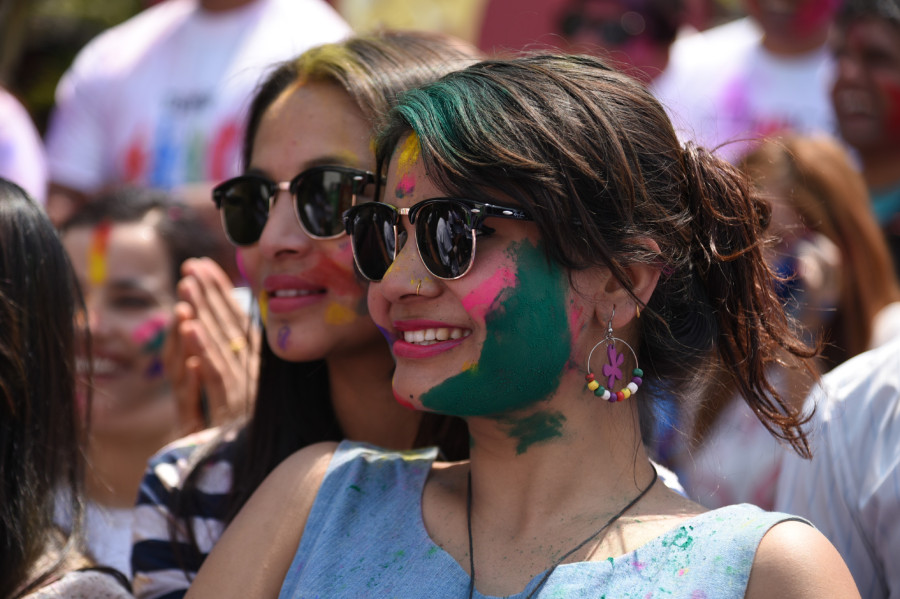Entertainment
No fear Holi
Up until a few years ago, many in Kathmandu, especially women, were afraid of Holi. Venturing out onto the streets even a week before festival day could invite a barrage of water balloons. No one was spared, neither those going to work nor students. Women, especially, were unwitting targets, often harassed and molested under the guise of throwing balloons or smearing colour. But lately, things have changed.
Rose Singh
Up until a few years ago, many in Kathmandu, especially women, were afraid of Holi. Venturing out onto the streets even a week before festival day could invite a barrage of water balloons. No one was spared, neither those going to work nor students. Women, especially, were unwitting targets, often harassed and molested under the guise of throwing balloons or smearing colour. But lately, things have changed.
Holi, the traditional Hindu festival of colours, celebrates the victory of good over evil and harkens the onset of spring. But in the Valley, the festival was often seen an excuse to drink, take drugs and harass women. Not anymore, says Shyam Lal Gyawali, Nepal Police Senior Superintendent.
“I’ve never celebrated Holi because I’ve seen women being harassed on the roads and in Holi events,” says 17-year-old Pallavi Sauden, who might be considering taking part in the festivities this year around.
Like in the years prior, the police will maintain a strict policy of booking those who force water and colours on passersby. Anyone throwing water balloons in the week leading up to Holi can be fined. The police encourages people to play Holi in private gatherings and inside their own compounds, without involving others who might not want to take part. These gatherings are safer and can be more fun, says Gyawali.
And these days, not many seem as interested in Holi as they might have been otherwise. Youngsters seem to prefer to spend their Holi holiday at home playing computer games rather than enjoying the festival to its fullest.
“Earlier, we played with colours for hours but now, people hardly play for an hour. The fun in neighbourhood has shifted to concerts,” says 19-year-old Pranit Chand Thakuri.

“Concerts and events, with permission from the District Council, bring together a large number of people. To maintain security at these events, police personnel stay alert in and around the areas,” says Gyawali.
Mischief making and harassment was long associated with the festival before the police began to crackdown on miscreants. Streets would start to empty during Holi week and women would fear leaving their homes.
Water balloons, or lolas, could appear from any rooftop and could contain anything from plain water to muddy water, petrol, sewage, and in extreme cases, even urine. There were some who’d even chuck eggs at passersby.
What was supposed to be a fun festival for all was warped into one that spread a climate of fear and hostility. In Thamel and Basantapur, where foreigners would congregate to celebrate the festival, molestation was rampant. It was a common sight to glimpse women wearing white t-shirts with a band of colour just around their chests. But the last few years have been regulated, peaceful and incidents of harassment and molestation have decreased noticeably, says the police.
According to tradition, the festival of Holi commemorates the story of Prahlad, a devotee of the god Vishnu. Hiranyakashyap, the demon king father of Prahlad, hated that his son adored Vishnu and ordered his
sister Holika to sit in a fire with Prahlad. Holika had been blessed with a boon that would protect her from fire, but ironically, through the power of Vishnu, Holika was burned away while Prahlad remained unscathed.
There are numerous other legends behind Holi, including the many other gods of the Hindu pantheon, including Shiva and Krishna. The religious aspects might have been forgotten but the celebratory part is alive and well. Holi is now celebrated in many parts of the world. There is the annual Festival of Colours Tour music festival that takes places on four different continents and the Colour Run, a 5k fun run where participants are doused with colour during the marathon. More recently, numerous events take place around the Valley, offering music, drinks, food and, of course, colour.
This year, Holi takes places on March 20 in the hilly region and on March 21 in the Tarai. In the southern plains, the festival is celebrated with much more energy and colour than in the hilly region. Special food is cooked for the festival and entire cities take part in the celebration.
“I was five years old when I first started playing Holi,” says 20-year-old Kishan Gupta from Birgunj. “Even today in the Madhes, Holi is as much about receiving blessings from elders and eating delicious malpuwas as it is about colours and water.”
For long, Holi has also provided an excuse to drink, not just alcohol but also bhaang-infused lassis. Bhaang—a cannabis product believed to be a prasad from the god Shiva—is traditionally associated with Holi and is still consumed across Nepal and India. But intoxication often led to unsavoury activities, especially when roving gangs of young men were involved.
“Fights between groups used to happen in the past. Some people have even died in such events,” says Gyawali of the Nepal Police. But such extremes have become less and less frequent and now, Holi is a relatively safe festival where locals and visitors can get together and celebrate, securely and without fear.




 14.12°C Kathmandu
14.12°C Kathmandu










